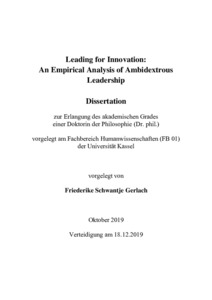Dissertation

Leading for innovation: an empirical analysis of ambidextrous leadership
Zusammenfassung
This dissertation investigates leadership in innovation processes. Based on ambidexterity theory, the focus is on the contradictory aspects of creativity and implementation within the innovation process and how leaders can support employees in addressing them. More specifically, this dissertation takes a within-process perspective looking at the influences of leader behaviors depending on different situations within the innovation process. The ambidextrous leadership model provides concrete leader behaviors defined to address the specifics of the innovation process. Thus, the relevance of these specific leader behaviors for the innovation process, i.e. opening and closing leader behaviors, is examined. Furthermore, the flexible adaptation of ambidextrous leader behaviors and the alignment of leader and follower behaviors with situational requirements of creativity and implementation is investigated. Three dissertation studies are described including a longitudinal field study across six weeks as well as two experimental designs manipulating leadership in the laboratory. The results emphasize the relevance of opening and closing leader behavior for leadership in innovation processes. Furthermore, it has been found that the alignment of leader and follower behaviors with situational requirements of creativity and implementation leads to higher innovation performance. Unfortunately, evidence for the flexible adaptation of ambidextrous leader behaviors was not provided. Nonetheless, this might be due to operationalizations of the flexibility component disregarding the alignment of leader behaviors with situational requirements. This dissertation adds to our understanding of leadership for innovation, because the within-process perspective for innovation is emphasized and provides evidence for the relevance of situational requirements of creativity and implementation. These aspects need to be considered by leaders to reach successful innovations.
Förderhinweis
DFG (RO 4647/3-1)Zitieren
@phdthesis{doi:10.17170/kobra-20200129969,
author={Gerlach, Friederike Schwantje},
title={Leading for innovation: an empirical analysis of ambidextrous leadership},
school={Kassel, Universität Kassel, Fachbereich Humanwissenschaften, Institut für Psychologie},
month={10},
year={2019}
}
0500 Oax
0501 Text $btxt$2rdacontent
0502 Computermedien $bc$2rdacarrier
1100 2019$n2019
1500 1/eng
2050 ##0##http://hdl.handle.net/123456789/11452
3000 Gerlach, Friederike Schwantje
4000 Leading for innovation: an empirical analysis of ambidextrous leadership / Gerlach, Friederike Schwantje
4030
4060 Online-Ressource
4085 ##0##=u http://nbn-resolving.de/http://hdl.handle.net/123456789/11452=x R
4204 \$dDissertation
4170
5550 {{Beidhändigkeit}}
5550 {{Flexibilität}}
5550 {{Führung}}
5550 {{Innovationsmanagement}}
7136 ##0##http://hdl.handle.net/123456789/11452
<resource xsi:schemaLocation="http://datacite.org/schema/kernel-2.2 http://schema.datacite.org/meta/kernel-2.2/metadata.xsd"> 2020-02-07T10:41:14Z 2020-02-07T10:41:14Z 2019-10 doi:10.17170/kobra-20200129969 http://hdl.handle.net/123456789/11452 DFG (RO 4647/3-1) eng Urheberrechtlich geschützt https://rightsstatements.org/page/InC/1.0/ leadership innovation ambidextrous leadership opening leader behavior closing leader behavior creativity implementation innovation requirements flexibility 150 Leading for innovation: an empirical analysis of ambidextrous leadership Dissertation This dissertation investigates leadership in innovation processes. Based on ambidexterity theory, the focus is on the contradictory aspects of creativity and implementation within the innovation process and how leaders can support employees in addressing them. More specifically, this dissertation takes a within-process perspective looking at the influences of leader behaviors depending on different situations within the innovation process. The ambidextrous leadership model provides concrete leader behaviors defined to address the specifics of the innovation process. Thus, the relevance of these specific leader behaviors for the innovation process, i.e. opening and closing leader behaviors, is examined. Furthermore, the flexible adaptation of ambidextrous leader behaviors and the alignment of leader and follower behaviors with situational requirements of creativity and implementation is investigated. Three dissertation studies are described including a longitudinal field study across six weeks as well as two experimental designs manipulating leadership in the laboratory. The results emphasize the relevance of opening and closing leader behavior for leadership in innovation processes. Furthermore, it has been found that the alignment of leader and follower behaviors with situational requirements of creativity and implementation leads to higher innovation performance. Unfortunately, evidence for the flexible adaptation of ambidextrous leader behaviors was not provided. Nonetheless, this might be due to operationalizations of the flexibility component disregarding the alignment of leader behaviors with situational requirements. This dissertation adds to our understanding of leadership for innovation, because the within-process perspective for innovation is emphasized and provides evidence for the relevance of situational requirements of creativity and implementation. These aspects need to be considered by leaders to reach successful innovations. open access Gerlach, Friederike Schwantje 2019-12-18 157 Seiten Kassel, Universität Kassel, Fachbereich Humanwissenschaften, Institut für Psychologie Rosing, Katharina (Jun.-Prof. Dr.) Ohly, Sandra ( Prof. Dr.) Gielnik, Michael (Prof. Dr.) Material of the experimental set-up in the appendix DFG (RO 4647/3-1) Beidhändigkeit Flexibilität Führung Innovationsmanagement publishedVersion </resource>
Die folgenden Lizenzbestimmungen sind mit dieser Ressource verbunden:
Urheberrechtlich geschützt

